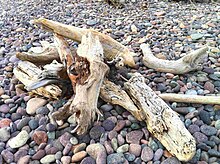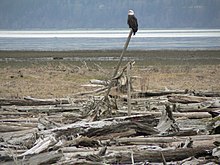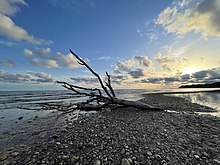



Driftwood is wood that has been washed onto a shore or beach of a sea, lake, or river by the action of winds, tides or waves. It is part of beach wrack.
In some waterfront areas, driftwood is a major nuisance. However, the driftwood provides shelter and food for birds, fish and other aquatic species as it floats in the ocean. Gribbles, shipworms and bacteria decompose the wood and gradually turn it into nutrients that are reintroduced to the food web. Sometimes, the partially decomposed wood washes ashore, where it also shelters birds, plants, and other species. Driftwood can become the foundation for sand dunes.
Most driftwood is the remains of trees, in whole or part, that have been washed into the ocean, due to flooding, high winds, or other natural occurrences, or as the result of logging. There is also a subset of driftwood known as drift lumber. Drift lumber includes the remains of man-made wooden objects, such as buildings and their contents washed into the sea during storms, wooden objects discarded into the water from shore, dropped dunnage or lost cargo from ships (jetsam), and the remains of shipwrecked wooden ships and boats (flotsam). Erosion and wave action may make it difficult or impossible to determine the origin of a particular piece of driftwood.
Driftwood can be used as part of decorative furniture or other art forms, and is a popular element in the scenery of fish tanks.